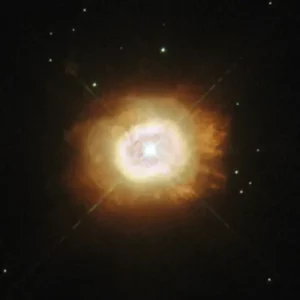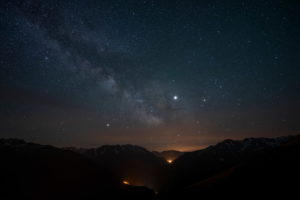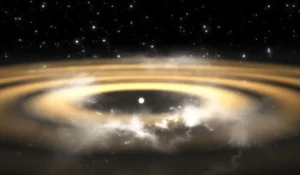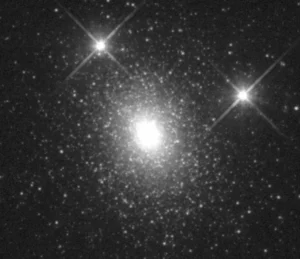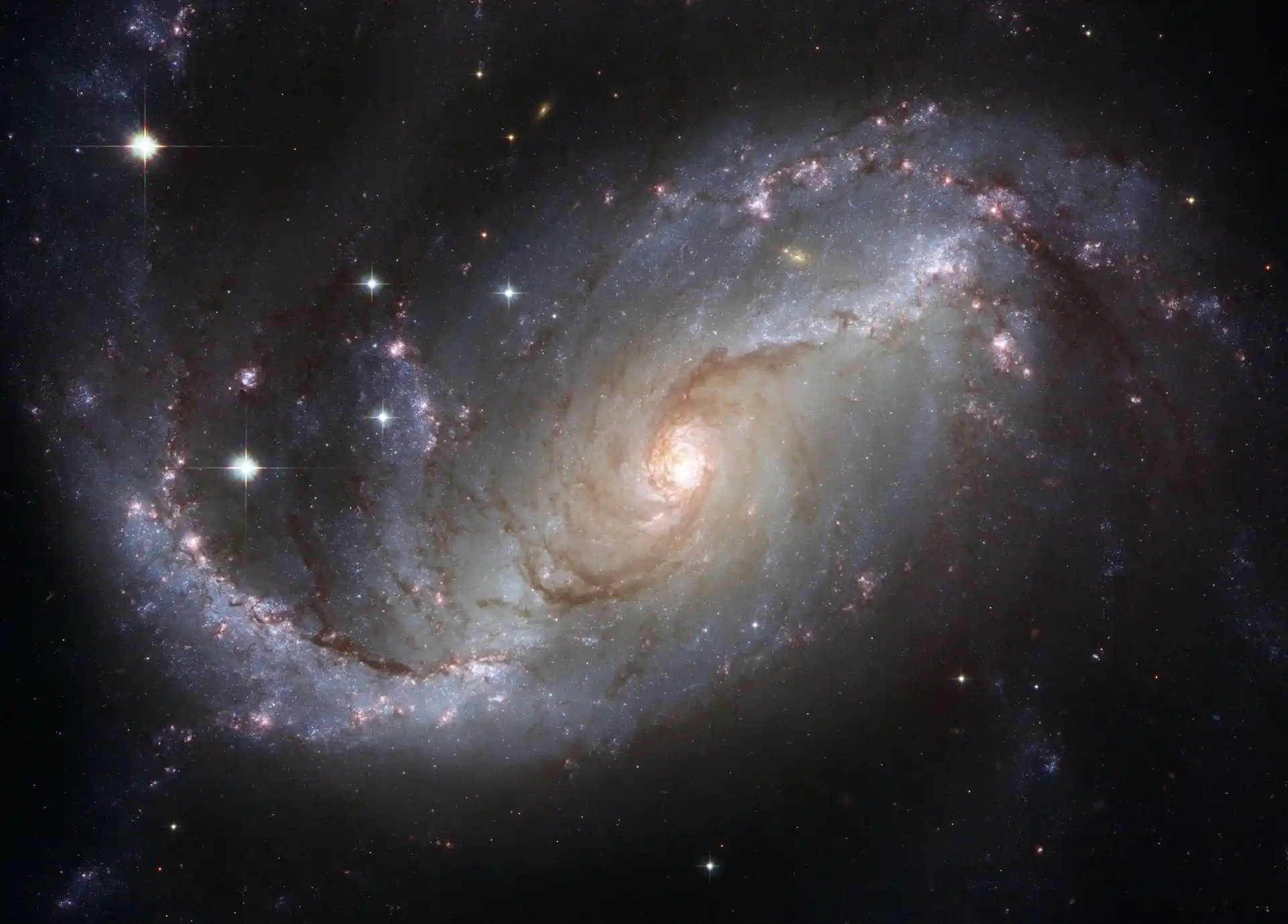
Galaxies – Information and Observations
Until 1924 everybody believed that the Milky Way galaxy, a swirling collection of stars a few hundred thousand light-years across, made up the entire universe.
That was until Edwin Hubble spotted a Cepheid variable star in the Andromeda Nebula, and using different techniques showed that the nebula was nearly a million light-years away, far beyond the bounds of the Milky Way. Before this astronomers thought that galaxies (or “spiral nebulae”) are just clouds of interstellar gas, inside our own Milky Way galaxy.
These days any amateur astronomer using a small telescope can see hundreds of galaxies, millions of light-years away. Mainly there are three types of galaxies you can observe:
• Spiral galaxies like our own are the most common type, they are made of spiraling arms of stars and dust coming from a central core. Seen through the telescope they appear like small round or slightly elongated patches of light, when we see them face on. If the galaxy is seen from the edge it will have a very elongated, spindle-like shape.
• The second type of galaxy is called elliptical. Seen through the telescope they are usually circular, or ovals that are near circular in shape. Most of the galaxies belonging to this type are bright, but they lack any observable details.
• Irregular galaxies have no definite shape, being formed of chaotic agglomerations of stars and gas. One example of an irregular galaxy is Messier’s catalog M82, in Ursa Major.
Galaxies observed with a 150-mm telescope
M106 is a bright galaxy in Canes Venatici. It is large and elongated, near the faint nucleus I’ve seen a 10th magnitude star.
NGC 4036 is a 11.6 magnitude galaxy in Ursa Major. In the eyepiece it appears small and elongated with a very bright nucleus.
13th-magnitude NGC 5198 is located only a few arcminutes from M51, the great galaxy in Canes Venatici. It is easily seen in the eyepiece, it has a stellar nucleus.
NGC 5557 is a 12.2 magnitude galaxy in Bootes. It is pretty large, with a bright nucleus. This galaxy shares the same field with NGC 5529, a faint galaxy glowing at magnitude 12.7. NGC 5529 is barely visible at 70x, on the charts it appears very elongated but seen through the eyepiece it is round and very small.
NGC 5350, NGC 5354 and NGC 5353 in Canes Venatici form an interesting group, three 12.5 magnitude galaxies clustered in a space of five arcminutes. NGC 3550 is the largest of the group, diffuse, without condensation towards the nucleus. NGC 5354 and NGC 5353 are much smaller and very close one to another. Both have stellar nuclei.
NGC 2855 is a 12.3 magnitude galaxy in Hydra, located 25 arcminutes west of 26 Hydrae. It has a round shape and small size, with a diffuse but evident nucleus.
Separated by only 25 arcminutes from the famous globular cluster M13, you will find NGC 6207, a 12.2 magnitude galaxy. It has an elliptic shape, with condensation towards the bright nucleus.
NGC 4041 is a bright galaxy in Ursa Major. It is large, round shape, with a bright center.
In the vicinity of Cor Caroli you will find NGC 4914 and NGC 4868. NGC 4914 is 12th magnitude, small size, round, with an easily seen diffuse nucleus.
13th magnitude NGC 4868 it’s difficult to observe, but the nucleus is fairly evident.
NGC 7742 is small and faint. I’ve observed a dim star very close to the galaxy.
NGC 7743 is a lot larger then NGC 7742. It is round, without an evident nucleus.
NGC 7785 is a small, faint galaxy in Pegasus. It is elongated and has a stellar nucleus.
NGC 5320 is fairly big, its shape is difficult to observe, and using averted vision it seems elliptical. Seen directly it seems round. It is diffuse towards the edges and has a stellar nucleus. To the west, near the galaxy, you will find a bright star.
Galaxies observed with a 114-mm telescope
NGC 185 is a difficult galaxy belonging to the local group. It is faint, but visible with direct vision at 50x. It has an irregular shape, with diffuse evenly spread light.
NGC 4237 in Coma Berenices is a 11.7 magnitude galaxy. In the eyepiece it appears large, with a faint and diffuse nucleus. Along the northern edge I’ve seen three faint stars.
NGC 4559 is one of the most interesting galaxies I have ever seen. In the elongated body of the galaxy, using 120x, I’ve observed three stars aligned in a north-south direction. The most northern star is visible with direct vision, but for the other two I had to use averted vision. The star to the north is TYC-1992-1757-1 (magnitude 11.86), and the other two to the south are GSC 1992-1659 (magnitude 12.35) and GSC 1992-2058 (magnitude 13.4).
M91 and M88 are two galaxies that share the same visual field, located in the Virgo-Coma cluster. They look very alike, bright and large.
NGC 891 is one of the most famous galaxies. Seen trough a 114-mm telescope is quite difficult, due to its low surface brightness. I have managed to see it only with averted vision, its elongated spindle shape is easily visible. Of course no trace of an equatorial line.
NGC 4312 is at the absolute optical limit for a 114-mm telescope. Its magnitude is 11.8, I’ve barley managed to see it, but the identification is positive.
NGC 4379 is a difficult 11.7 magnitude galaxy. It is small and faint, the nucleus is visible only with averted vision.
NGC 4350 is located only a few arcminutes west from NGC 4340. It is difficult and appears as a small diffuse cloud that surrounds a very bright nucleus.
11th magnitude NGC 4340 is small, round, without an evident nucleus.
NGC 4595 is round, bright, and has a diffuse nucleus.
NGC 4293 is elongated, it has a diffuse faint nucleus. Near the western edge I’ve observed two faint stars.
NGC 4236 is an extremely difficult galaxy in Draco, magnitude 9.7 but 22.5’x6.5′ size! I’ve managed to observe it only after a few minutes of staring in the eyepiece, using averted vision.
NGC 4261 is faint, round, with a diffuse nucleus.
NGC 4725 is 9.8 magnitude, and easily seen with direct vision. It is elongated and becomes brighter towards the nucleus.
NGC 4565 is located four degrees southeast of 31 Comae Berenices. It is easily seen even through a 50-mm finder scope, from a location with a dark sky. Its size is 15’x2′, in the eyepiece it appears extremely elongated, with a bright diffuse nucleus. The nucleus doesn’t have the typical round form, it appears elongated as well. I haven’t managed to see the dark equatorial line.
NGC 4494 is located near the double star 17 Comae Berenices, easily separated into magnitude 5.5 and 6.6 components. The galaxy is faint, with a diffuse nucleus. Near the northern edge I’ve seen an 8th magnitude star.
Two degrees north from NGC 4494 you will find 11th-magnitude NGC 4448. It is easily seen with direct vision, elongated, without condensation towards the nucleus.
NGC 4278 shares the visual field with other three galaxies. Its magnitude is 11.1, it has a round shape and a bright almost stellar nucleus.
NGC 4274 is a little elongated, brighter then NGC 4278, but I didn’t manage to observe a nucleus.
The third galaxy in this group is NGC 4245, difficult to see with direct vision, it has a round shape without an evident nucleus.
The last galaxy is NGC 4314, 11.3 magnitude, elongated, with an easily seen diffuse nucleus.
NGC 4203 is an extremely small galaxy, with a size of only 0.8 arcminutes. It appears as a small round patch, without condensation towards the center.
NGC 4631 (magnitude 9.6) and NGC 4656 (magnitude 10.6) appear in the same visual field. Both galaxies have the same size – 15′ x 2.5′. NGC 4631 is easily seen with direct vision, but NGC 4656 is barley detectable even with averted vision.
NGC 4125 is a faint galaxy in Draco, elongated and with a poorly evident nucleus. In the southern part of the galaxy I’ve seen a 10th-magnitude star.
M108 shares the same field with the Owl Nebula, it’s faint and elongated.
NGC 3227 is extremely difficult. It appears very faint, but I’ve managed to see its elongated shape, without condensation towards the nucleus.
NGC 3607 and NGC 3608 are extremely close one to another, only 5 arcminutes apart. NGC 3607 is almost a magnitude brighter than NGC 3608. It has a round shape, with a stellar nucleus. NGC 3608 is also round, it has a diffuse nucleus. I’ve seen two faint stars in the galaxy’s body.
NGC 3686 is faint and diffuse, it has a round shape. No condensation towards the nucleus.
NGC 2903 is a bright galaxy in Leo. It is large and a little elongated. Near the eastern edge I’ve seen two faint stars. Close to the bight diffuse nucleus, I’ve managed to seen another star with averted vision.
NGC 3184 is a very strange galaxy, with a ghostly dark grey glow. I haven’t seen a similar shade in any other galaxy. The shape is exactly round, without central condensation. I’ve seen a star in the western part of the galaxy. Other two objects (NGC 3180 and 3184) have the same equatorial coordinates, but these are catalog errors.
NGC 5676 – faint, small, round shape. It has a diffuse and faint nucleus.
NGC 3640 is difficult, I’ve only managed to seen a round patch of light, without an evident nucleus.
M66 is a bright galaxy in Leo. It has a bright nucleus and a 9th-magnitude star near the edge.
NGC 3384 is round, it has a stellar nucleus similar in brightness with a 10th-magnitude star.
NGC 3628 is very elongated, it has a faint nucleus.
M65 has an elongated shape, with a faint but well-defined nucleus.
M96 is bright, a little elongated, it has a stellar nucleus.
M105 shares the same field with M 96, it has a round shape.
Although its magnitude is 7.7, because its large size, M101 doesn’t appear very bright. It has a round shape, the nucleus is poorly defined.
At 36x, M51 appears round with a bright nucleus. The arm that bounds it to NGC 5195 is easily seen. If you concentrate, it is possible to see the diffuse disk of the galaxy separate into two spiral arms. I’ve managed to see them using averted vision.
M63 is an interesting galaxy, it has a stellar nucleus. It appears elongated, placed between one bright star at one edge and two other faint stars at the other edge.
M33 is a bright galaxy, I have seen it event through my 50 mm finder scope. Some observers manage to see it with the naked eye, from dark locations. Using 36x it fits entirely in the visual field. I’ve didn’t managed to see any details.
M81 is very bright, easily seen even in the finder scope. I have managed to see some details, some darker parts in the galaxy’s body. It becomes gradually brighter towards the center.
Seen through a 114-mm telescope M31 it is not very spectacular, I’ve couldn’t manage to see any details. At 36x it appears so large that it doesn’t fit in the visual field. The nucleus is extremely large and bright.
M32 is very close to M31, it has an almost round shape and is very bright.
NGC 205 (M110) is larger than M32, but a lot fainter.
M83 in Hydra is a difficult galaxy due to its proximity to the horizon. It is large, round, with a stellar nucleus.
M98 is located a little to the west of 6 Comae Berenices. It is elongated, with a faint but well-defined nucleus.
M84 and M86 share the same visual field. Both galaxies are round, with bright nuclei.
Near the border between Virgo and Corvus you will find M104 (The Sombrero Galaxy). It has a very large and bright nucleus.
M74 is a difficult galaxy in Pisces. I’ve barley managed to see it, it looked a little elongated.
NGC 6946 is located in Cygnus, strange place to be for a galaxy. It is round and appears in the same field with open cluster NGC 6939.
NGC 7479 in Pegasus is faint, without an evident nucleus. The galaxy is elongated, and gets a little brighter towards the center.
NGC 7331 is the brightest galaxy in Pegasus. It is easily seen at 50x, the bright nucleus is almost stellar.
NGC 7332 is visible with direct vision at 50x. The galaxy is faint, elongated, with a bright core.
NGC 7339 is only visible with averted vision. Using 120x I’ve barley seen the elongated shape.
Galaxies observed with a 60-mm telescope
M81 – Galaxy in Ursa Major. Small, elongated, brighter towards the center.
M82 – It appears in the same field with M81. Elongated, very difficult.
M31 – The elongated shape is visible even with the naked eye. The galaxy is very large, it doesn’t fit in the eyepiece field.
M33 – This galaxy is visible even with the naked-eye under good conditions. Through the eyepiece it appears like an oval fuzzy patch, slightly brighter towards the core. There is no hint of dark regions or spiral structure.

Emil, an avid astronomy writer, formerly owned and ran nightskyinfo.com, making the universe more comprehensible for his readers. He has recently handed over its reins to Tom Urbain from starlust.org, ensuring that his legacy of simplifying the stars continues to enlighten and inspire.
Discover More Deep Sky Objects to Observe🔭
This page is part of our collection of deep-sky objects articles. If you enjoyed the read, then you’ll love the following articles.

